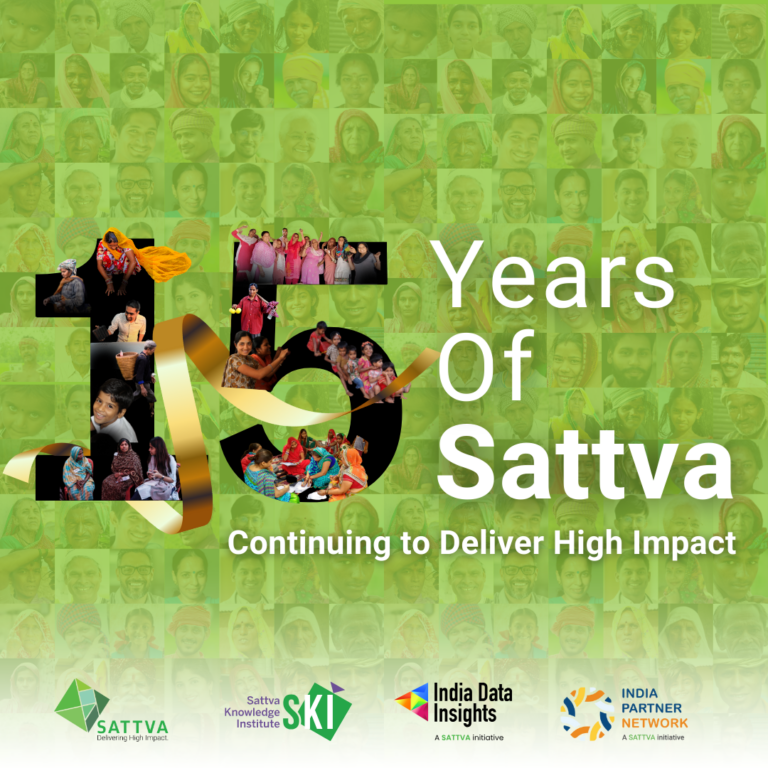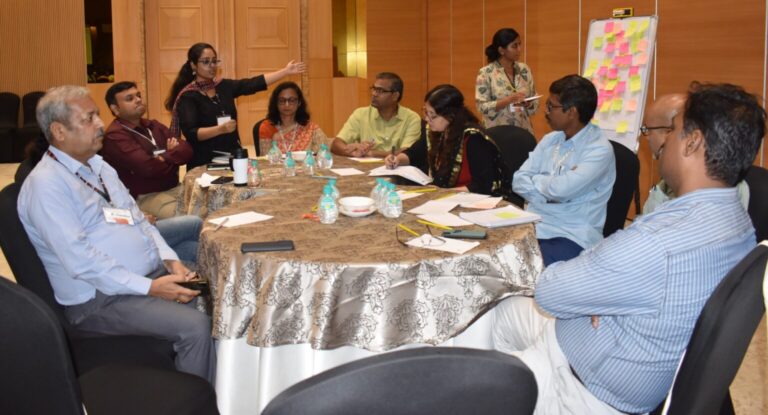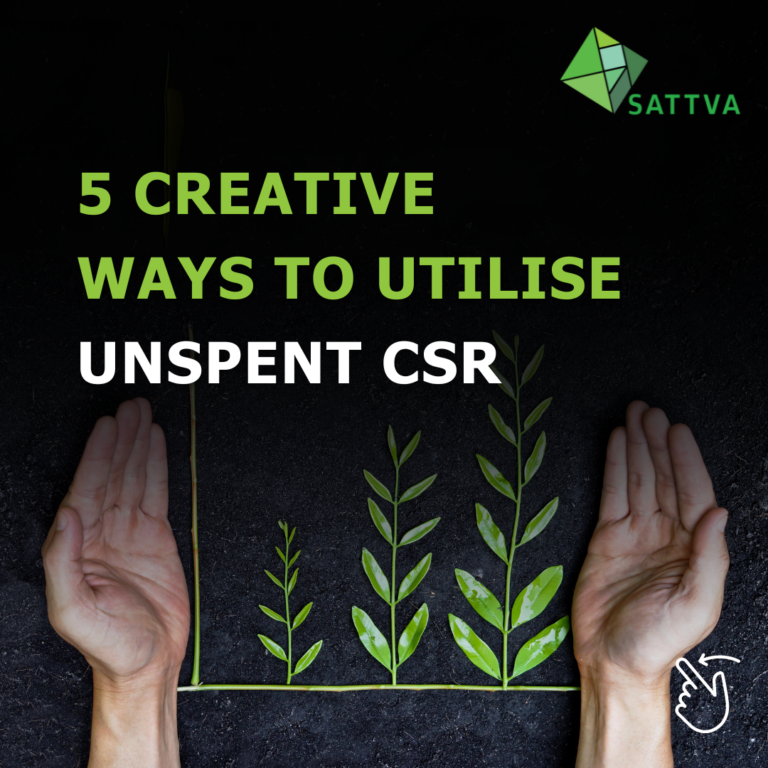In July 2021, I moved into a full-time role in the social impact sector after a couple of decades in the enterprise software industry. I’d spoken about this transition – from the corporate to the social sector – with a few friends (one of them over a podcast episode), and I’d read a few articles on the subject. I thought I had a reasonably fair idea of what this would entail. The reality turned out more complex and more nuanced, offering challenges and opportunities I hadn’t expected at the outset.
The first hints of this gap (in my expectations versus reality) came during my introductory conversations with a cross section of people at Sattva. Given my long tech background, I’d taken some technology knowhow – common in IT circles – for granted, and my speech was sprinkled with jargon I didn’t think twice about. In one such conversation, after listening to me for a while, a colleague asked,
“What’s an API?”
The question caught me by surprise. It was evident that I had to reset my expectations on tech-awareness and adoption in this sector, and also change the way I presented my worldview in this new space.
This difference (in worldview, in understanding) existed in both directions. Every third conversation during those initial months brought up the phrase “Theory of Change”: I had not heard of it even once in my long tech career.
What struck me during those months was the diversity of backgrounds and experiences of most people in Sattva. Unlike the software engineers and product managers I’d worked previously with (who came from an engineering or management background), the picture that emerged from Sattva employees covered a broader palette, spanning social sciences, arts, humanities, economics and a few from engineering and management backgrounds too. And unlike typical IT folks who are driven by market forces – or a mix of tradition and societal expectations – to choose their line of study and work, my new colleagues had consciously chosen their field of work, often out of a desire to make a difference to society.
This diversity in my new workplace seemed apt, given the multiplicity of domains and stakeholders I found among the projects at Sattva. We worked with Foundations, Corporates, Non-Profits, Social Enterprises, Government agencies (among others) across a range of sectors including health, agriculture, livelihood, and education. This was clear from the start, and I understood it intellectually. But a year into my new role I experienced this diversity first-hand during two visits in the same month.
The first was a field visit to Rajasthan, to observe some education camps set up in remote villages. The project was part of an NGO’s efforts to improve adolescent girls’ education in marginalised communities, and these village “camps” were modest setups: we sat on the floor of a small room with a dozen students, and watched the tutor facilitate a class. Later there was a focussed-group discussion with a set of tutors from that area, again in a similar setting: on the floor of a room with a leaky roof, adorned with photos of ancestors and some framed certificates. A few weeks later, on a different project, I found myself sitting in the coffee shop of a five-star hotel in New Delhi, talking about a proposal with an international foundation which had funded a part of this project. There were expensive works of art around us, and the seating was plush. The contrast between the two meetings was stark, and it showed two different sides of this ecosystem: where the money was flowing from and into. Sattva had to work with both sides, and embrace this contrast. This was integral to our mission.
Technology was another area where I encountered several differences. In my earlier avatar I had worked for SAP, a software company that built products for medium to large-size enterprises. I’d written about the challenges in building B2B products, but developing and deploying technology for the development sector (Tech4Good, as some call it) revealed facets I’d not seen before.
There were new constraints to consider, like access to digital infrastructure and the digital literacy of target users. Further, we could no longer assume English proficiency, even for early adopters. Designing software under these constraints was a new experience, something that made the traditional B2B or B2C scenarios seem a lot easier in comparison.
Availability of talent to build software at a reasonable cost was another challenge. With the tech industry luring people with large pay packages and 30% or higher increases each year, hiring and retaining experienced tech professionals in the development sector requires an approach that goes beyond money as an incentive. (Interestingly, I found that Sattva had some great tech talent – like a computer science BTech from a leading university, who had previously worked on machine learning – but these folks had consciously moved away from tech, and were keen to spend their time and energy in other social sector domains. This initially struck me as a loss, but over time I realised that their background came in handy in projects that intersected with tech. Which, these days, is not infrequent.)
I also discovered a disconnect in the space of what people wanted from technology. There were conversations where people saw technology as a silver bullet and came up with outlandish expectations, like a WhatsApp add-on that offers real-time translation into several Indian languages in a chat between multiple people. (Even at the current pace of development in natural language processing, this is a few years away). In other instances, I found that users were unable to accept that software could have bugs: when an issue surfaced in an app, the first inclination was to abandon its usage and move to the state before (like using pen and paper, or just a spreadsheet).
Such mindsets, and the gaps in digital literacy among many users, underscored the importance of change management while targeting adoption of software in such environments. I’ve learned that designing for value, rather than compliance, is a key prerequisite to higher user acceptance and adoption.
Then there was scale. I’d heard of “Internet scale” before, but in this ecosystem people spoke about “population scale”. The need of the hour, they said, was for solutions that don’t just work well locally but can scale across India. This need was reflected in the significant progress made recently with “Digital Public Goods” or “Digital Public Infrastructure”, like the India-Stack.
This population-scale thinking is related to a mindset (within Sattva, and this impact ecosystem) of thinking more about the country and less about the company we work for. It is reflected in our projects, like the Bharat Initiative, and products, like India Data Insights. In some contexts, like climate change, the scope and imagination is even broader, encompassing all of our biosphere. Previously, in the enterprise software market industry I was a part of, it was competition that largely drove our thinking (about the company’s strategy and its future); in Sattva, the mantra is collaboration, not competition.
Transitions of this nature are seldom managed alone. I joined Sattva as a newcomer to the social sector, and my colleagues helped me navigate this unfamiliar territory, pulling me along for field visits, patiently answering my naive questions, and perhaps most importantly, giving me the space to explore and learn.
All of this makes my earlier occupation seem a lot less exciting, and I don’t think this is an exaggeration. In contrast to the enterprise software sector I was engaged in previously, the impact sector is more diverse, more challenging, not as mature (technology-wise), and offers a large potential for impact in areas where society needs it most. Working in this sector in the last couple of years has given me a level of satisfaction and joy I had not experienced before. I sometimes wish I’d taken the plunge sooner.
Manohar Sreekanth is a partner and CTO at Sattva Consulting, responsible for Sattva’s technology and data related products and services, and for Sattva’s digital transformation. Read more, here.




